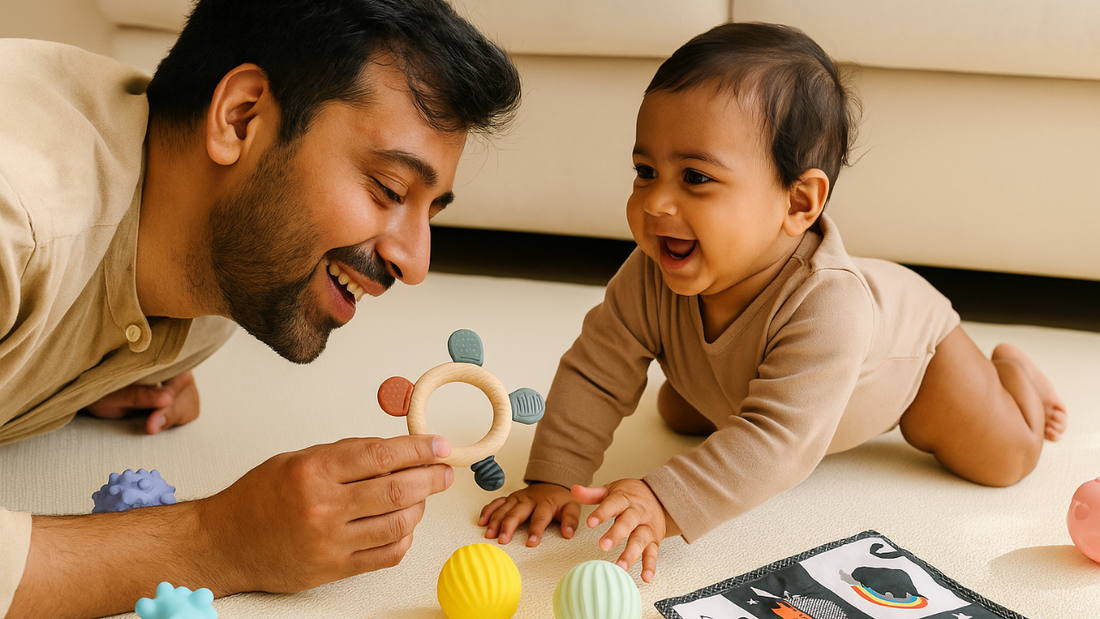
Sensory Play for Infants: Everyday Activities That Engage Their Senses
LiLLBUDBabies are natural scientists from birth, using their senses of touch, sound, sight, smell, and movement to investigate their surroundings. That’s why sensory play for infants is more than just cute playtime; it serves as the basis for physical growth, emotional regulation, and brain development.
The best part? You don’t need a Pinterest-worthy setup or expensive tools. Some of the most effective baby sensory play can take place right in your home, using things you already own.
In this post, we will explore simple, everyday activities that offer sensory stimulation to babies–helping your baby to become curious, relaxed, and confident from birth.
Why Sensory Play Matters for Babies
This type of play activates your baby’s brain by introducing new experiences through their senses (sight, sound, touch, taste, and movement). It benefits them by:
-
Building cognitive connections
-
Developing fine and gross motor skills
-
Strengthening body awareness and coordination
-
Supporting language and social development
By engaging several senses at once, babies begin to comprehend how their body interacts with the world–and that is the very first step toward independence.
What Types of Sensory Play Should Infants Experience?
During the first year, focus on:
-
Tactile play (textures, temperatures, safe objects to grasp)
-
Auditory play (rattles, lullabies, soft sounds)
-
Visual stimulation (High-contrast colors, movement)
-
Oral play (safe mouthing toys, silicone teethers)
-
Movement-based play (tummy time, bouncing, swaying)
Your baby’s brain gets a healthy dose of stimulation without becoming overwhelmed by rotating a variety of infant development toys and homemade sensory activities.
Everyday Sensory Activities for Babies (0–12 Months)
1. Tummy Time with a Twist
Include textured material, crinkle mat or paper, or a high-contrast tummy time toy during tummy sessions. Place a mirror in front for them to see their reflection and follow movement.
2. DIY Sensory Bottles
Fill a few transparent bottles with water, glitter, beads, or small safe objects and secure the bottles tightly. Let the baby watch its motion or let them roll it during their play time.
3. Music and Sound Exploration
Use baby-safe instruments, soft rattles, or chimes. Sing to the baby and see how they react to rhythm and tone.
4. Soft Touch Basket
Fill a basket or a carton box with safe textures such as a soft cloth, silicone brush, smooth spoon, and a cotton scarf. Have the baby to explore using their hands or feet.
5. Mess-Free Painting in Ziplock Bags
Fill a closed ziplock bag with a few drops of baby-friendly paint with a white sheet. Secure it down to a surface and allow the baby to squish and smear without making a mess.
Tips for Safe and Effective Sensory Play
-
Follow your baby’s cues– if they seem overstimulated, stop or slow down
-
Always supervise closely, especially when they are playing messy or handling small objects.
-
Use natural materials whenever possible (like wood, cotton, silicone)
- Keeping sessions short at first 5 to 10 minutes is enough for younger infants.
-
Include play into daily routines like feeding, bathing, and changing diapers.
Observe signs of interest such as kicking, cooing, reaching, or concentrated eyes–these indicate that your baby is learning!
Little Moments, Big Impact
You don’t require high-tech gadgets or complicated activities to promote your baby’s development. Using a few Montessori-inspired sensory activities, simple toys, and daily routines, you can provide rich, brain-boosting experiences that fuel your baby’s growth–one giggle, squish, and sparkle at a time.
So next time you are folding laundry, cooking dinner, or relaxing on the floor, bring your baby into a sensory moment. These early experiences are laying the foundation for a lifetime of learning.

